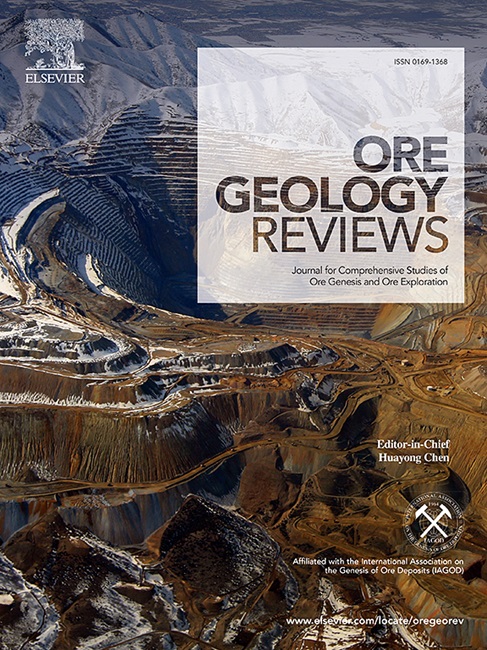Extremely Fe-rich beryl from Zhangji deposit: Implications for the unique volcanic fluid environment of beryllium mineralization in Southeast China
IF 3.2
2区 地球科学
Q1 GEOLOGY
引用次数: 0
Abstract
Beryl group minerals and bertrandite have been identified in the altered rocks of the Zhangji deposit in the volcanic intrusion complex of Southeast China. Complex internal textures and compositional variations characterise two groups of beryl (primary magmatic beryl and secondary hydrothermal beryl). The primary beryl (Brl-I) with low FeOT (<1.52 wt%), Na2O (< 0.27 wt%), and minor MgO (<0.07 wt%) showed a regular hexagonal crystal shape, compositional rhythmic annulus, and a planar contact relationship with primary K-feldspars. With the action of hydrothermal fluids, two types of secondary beryl can be distinguished: (1) The Fe-, Mg-, and Na-rich beryl (Brl-II-1), with up to 5.74 wt% FeOT, 2.60 wt% MgO, and 2.31 wt% Na2O occurs along fractures in beryl crystals. (2) The extremely Fe-enriched beryl (Brl-II-2) has with up to 11.59 wt% FeOT, 1.70 wt% MgO, and 1.53 wt% Na2O and is related to extended metasomatism of Fe-rich fluids. Furthermore, the detailed textural study revealed that beryl evolved through reactions to form bertrandite, K-feldspar, and muscovite. Compared with primary K-feldspar which exhibited a clear contact boundary with surrounding minerals, secondary K-feldspar was adularia and lacked complete crystal form. In addition, compared with primary muscovite which was a long lamellar crystalline shape, secondary muscovite was distributed in clusters in beryl and showed as small grains with higher Fe content. Fe-rich beryl is rarely reported, to our knowledge, the extremely Fe-, Mg-, and Na-rich beryl in Zhangji deposit contains the second highest Fe content in the world, only lower than that found in Latium (Italy), of the metallogenic environment formed as a result of iron-rich and strong oxidation fluids. The strong volcanic magmatic activity during the Late Mesozoic formed a volcanic intrusion complex in Southeast China, this extremely Fe-rich beryl was formed in the special volcanic hydrothermal environment of the volcanic intrusion complex along Southeast China.

求助全文
约1分钟内获得全文
求助全文
来源期刊

Ore Geology Reviews
地学-地质学
CiteScore
6.50
自引率
27.30%
发文量
546
审稿时长
22.9 weeks
期刊介绍:
Ore Geology Reviews aims to familiarize all earth scientists with recent advances in a number of interconnected disciplines related to the study of, and search for, ore deposits. The reviews range from brief to longer contributions, but the journal preferentially publishes manuscripts that fill the niche between the commonly shorter journal articles and the comprehensive book coverages, and thus has a special appeal to many authors and readers.
 求助内容:
求助内容: 应助结果提醒方式:
应助结果提醒方式:


